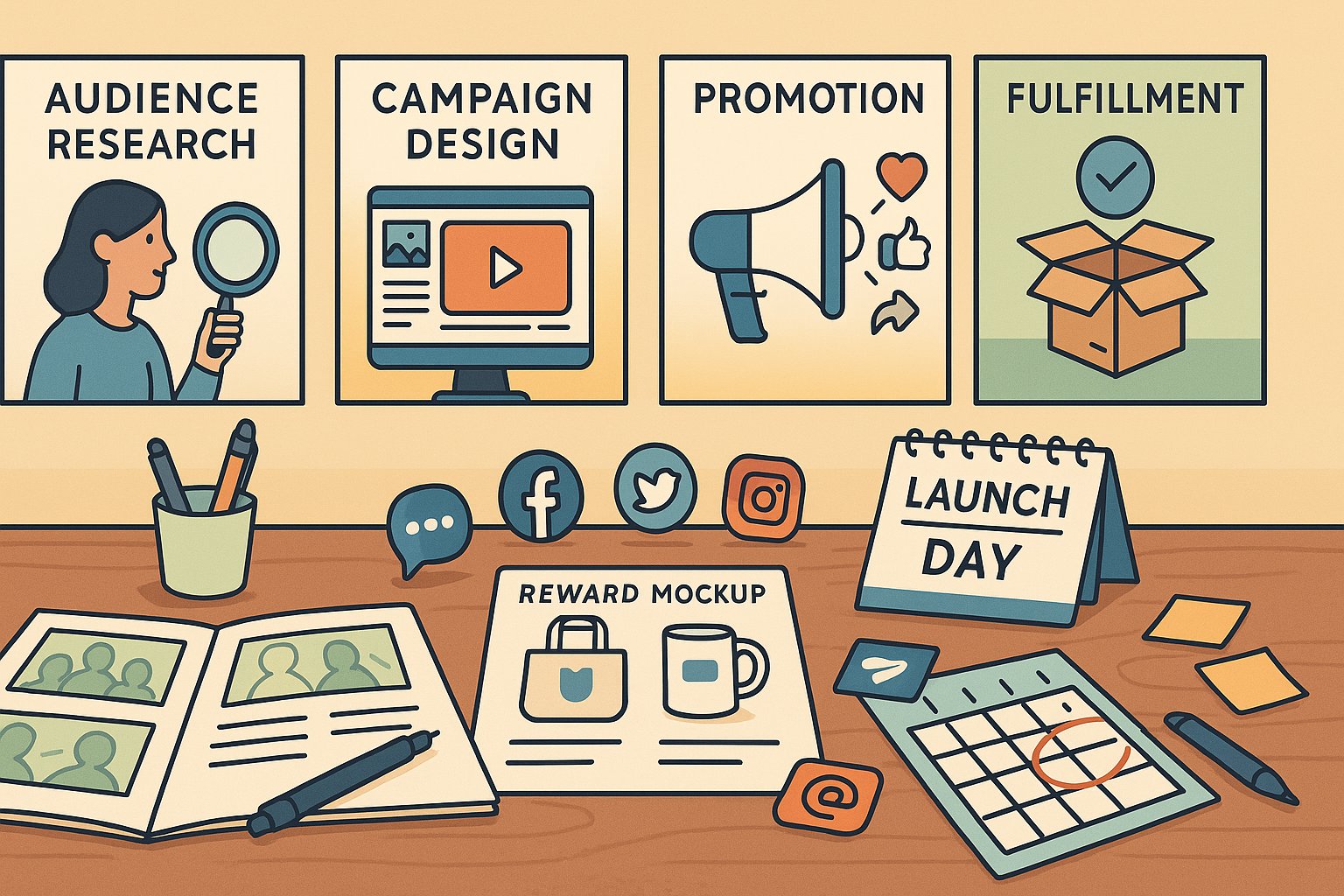Introduction: Why Planning Is the Make-or-Break Moment for Your Campaign
Embarking on a crowdfunding campaign is like setting sail on uncharted waters: excitement and opportunity abound, but hidden shoals of missteps can dash even the most promising ventures against unseen rocks. In today’s saturated crowdfunding ecosystem, where thousands of projects vie for backer attention every day, diligent planning is the single most critical factor that separates triumph from defeat. A brilliant idea alone won’t carry you across the finish line; without a rock-solid strategy, transparent budgeting, and meticulous timeline management, your campaign risks folding under the weight of avoidable errors. Moreover, backers demand professionalism, accountability, and authenticity—qualities that only emerge when your campaign exhibits a well-thought-out roadmap rather than spur-of-the-moment improvisation. True campaign planning begins with smart groundwork: identifying your target audience’s motivations, researching comparable projects, and auditing your own capacity for communication and delivery. It extends through the nitty-gritty of prototype refinement, budgeting for manufacturing, contingency fund allocation, and fulfillment logistics. It encompasses the art of crafting a compelling narrative, producing engaging multimedia content, and orchestrating pre-launch buzz so that Day One momentum sends a clear signal to crowdfunding platforms’ algorithms (and to potential backers) that your project is worth supporting. But even with the best intentions, common mistakes can derail your efforts—some obvious, others so subtle that you may not realize they’ve sunk your campaign until it’s too late. In this in-depth guide, we dissect the top ten crowdfunding campaign planning mistakes you must avoid to give your project the best possible chance of success. Each section uncovers a particular trap, explains why it happens, and offers insights on how to sidestep it. Whether you’re a first-time creator or a seasoned entrepreneur, understanding these pitfalls in advance equips you to navigate the entire campaign lifecycle—pre-launch, live period, and post-campaign fulfillment—with confidence. Let’s dive into the anatomy of campaign planning errors and learn how to chart a course toward a fully funded, well-executed outcome.
Mistake 1: Setting an Unrealistic Funding Goal
A funding goal that overshoots what your backer base can credibly deliver is a recipe for heartbreak. Creators sometimes let ambition eclipse practicality, calculating the dream budget without grounding it in real-world constraints. Without factoring in platform fees, payment processing charges, shipping costs, and potential production hiccups, even a seemingly achievable goal can leave you short of critical resources. The remedy is straightforward yet often overlooked: build your target from the bottom up. Solicit quotes from manufacturers, test shipping rates across regions, and include a contingency buffer of at least 10 to 20 percent. This disciplined approach ensures your goal reflects true project costs, giving you the financial runway to deliver on time and in full.
Mistake 2: Neglecting Pre-Launch Community Building
Relying solely on launch-day excitement is akin to banking on a single gust of wind to carry your ship across an ocean. Many campaigns ignore the invaluable pre-launch window, failing to cultivate an engaged audience before hitting “Go Live.” Without a pre-warmed email list, social followers primed for teasers, and initial press mentions, your Day One pledges can lag—causing algorithms to bury your project in the platform’s discovery pages. Instead, dedicate several weeks to authentically engaging with potential backers through behind-the-scenes updates, prototype sneak peeks, and early sign-up incentives. By the time you launch, a community ready and eager to pledge immediately transforms what could have been a dead heat into a dynamic opening sprint.
Mistake 3: Overlooking the Power of a Compelling Narrative
Facts and figures alone rarely ignite passion. Campaigns that dive straight into technical specs without weaving in emotional resonance risk appearing cold and transactional. Backers want to connect with your “why”—the personal journey that led you to solve a specific problem or the community you hope to impact. A powerful story blends authenticity, vulnerability, and vision, inviting supporters to become part of something meaningful. Allocate ample time to craft your origin story, highlight the human faces behind the project, and illustrate real-world scenarios where your solution makes a difference. A narrative well told not only captures attention but sustains interest throughout your entire campaign journey.
Mistake 4: Underestimating Multimedia Production
In a visual-first marketplace, amateurish photos and shaky videos can undermine backer confidence faster than any other misstep. Yet many creators attempt to slash costs by forgoing professional-grade imagery, believing the idea itself will compensate for technical flaws. The truth is that high-quality multimedia isn’t a luxury—it’s a cornerstone of credibility. A two-minute, well-lit video demonstrating your prototype in action, intercut with genuine testimonials and clear calls to action, dramatically increases engagement and pledge conversions. If budget is tight, consider partnering with film students or emerging photographers in exchange for product samples or early access. Investing in strong visuals pays dividends in trusted impressions and higher funding velocity.
Mistake 5: Ignoring Detailed Reward Tier Design
Reward tiers that confuse rather than clarify lead backers to abandon the pledge process mid-selection. Overly complex tier structures, redundant options, or unclear descriptions create friction at the moment of decision. Effective tier design aligns each pledge level with perceived value, offering a logical progression of benefits. Early-bird specials generate urgency but should be limited to small quantities to preserve exclusivity. Mid-range tiers cover production costs, while premium bundles can include personalized experiences or limited editions. Detailed descriptions—highlighting delivery timelines, item specifics, and any digital perks—remove ambiguity. Thoughtful reward architecture not only streamlines the backer journey but also ensures that your funding goal directly supports sustainable fulfillment.
Mistake 6: Failing to Plan for Contingencies
No project unfolds exactly as planned. Materials may go out of stock, prices can spike, or global events might disrupt shipping. Campaigns bereft of contingency plans often face cascading crises: delays that erode backer trust, rushed substitutions that compromise quality, or incremental costs that devour profit margins. Smart planners build a contingency fund—typically 15 to 25 percent of the total budget—into their funding goal and logistical timeline. Additionally, forging relationships with backup suppliers and fulfillment partners provides alternate pathways when primary vendors falter. By expecting the unexpected and planning accordingly, you safeguard both your timeline and your reputation.
Mistake 7: Skimping on Marketing and Outreach
Crowdfunding is equal parts fundraising and marketing. Treating promotion as an afterthought—for example, posting a couple of social updates without targeted outreach—leaves tremendous potential untapped. Successful campaigns employ diversified strategies: segmented email campaigns, paid social advertising tailored to lookalike audiences, influencer partnerships, and press releases to niche publications. They also track metrics in real time, iterating ad copy and audience parameters based on performance data. Crafting a robust marketing plan—and allocating sufficient time and budget to execute it—transforms your campaign from a solitary online page into a dynamic, far-reaching movement.
Mistake 8: Overlooking Backer Communication Protocols
Silence breeds suspicion. When backers don’t receive regular updates—celebrating milestones, sharing production photos, or explaining challenges—they start to wonder if they’ve been forgotten. Lack of clear communication protocols damages credibility and can trigger cancellations or negative feedback. Effective campaigns establish a communication cadence before launch: weekly or biweekly updates via platform posts and email, prompt responses to comments and inquiries, and personalized messages to high-tier supporters. Equally important is transparency when things go awry: timely explanations of delays with revised timelines and reassurance through stakeholder engagement. Consistent, honest communication cements trust and keeps backers invested as your project progresses.
Mistake 9: Neglecting Legal and Compliance Considerations
Crowdfunding may feel like a grassroots endeavor, but it remains subject to various legal and regulatory requirements. Ignoring terms of service on your chosen platform—especially around intellectual property, reward fulfillment, and equity offerings—can lead to campaign suspension or legal liabilities. Similarly, overlooking tax implications, export regulations for international shipping, or consumer protection laws in different jurisdictions exposes you to financial penalties. Engage a legal advisor early to review your campaign structure, reward descriptions, and fulfillment plans. This due diligence ensures you operate within the letter of the law, protecting both your project and your backers from unintended complications.
Mistake 10: Failing to Analyze and Iterate After Campaign Close
Many creators treat campaign closure as the finish line rather than a transition point. Without a thorough post-campaign analysis—evaluating conversion rates, backer demographics, reward performance, and channel ROI—you forfeit the insights needed to refine future projects. Equally important is gathering qualitative feedback from backers through surveys: understanding their motivations, frustrations, and suggestions for improvement. This data becomes the blueprint for your next crowdfunding effort or product launch, enabling you to avoid past mistakes, double down on successful tactics, and continuously elevate both your campaign strategy and your brand reputation.
Turning Potential Pitfalls into Pathways for Success
Crowdfunding offers an unparalleled opportunity to transform dreams into funded reality, but it demands rigorous planning and execution. By steering clear of these ten common pitfalls—unrealistic goals, neglected pre-launch engagement, weak storytelling, subpar multimedia, clumsy reward design, lack of contingency planning, insufficient marketing, poor communication, legal oversights, and missing post-campaign analysis—you equip your campaign for both immediate triumph and long-term growth. The essence of avoiding these mistakes lies in preparation, transparency, and adaptability. Treat every phase of your campaign as a strategic component in a cohesive narrative, and you’ll not only meet your funding targets but inspire a community of advocates eager to join you on your next journey.




